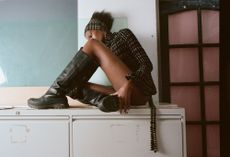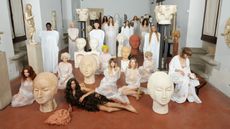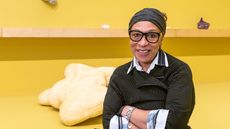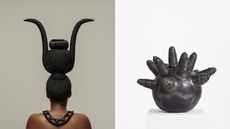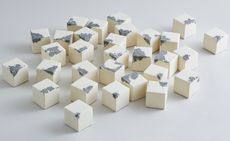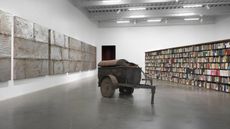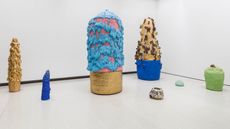Ceramic artists: top trail-glazers breaking the mould
A way with clay: discover the contemporary ceramic artists firing up the canon into a new age
- (opens in new tab)
- (opens in new tab)
- (opens in new tab)
- Sign up to our newsletter Newsletter
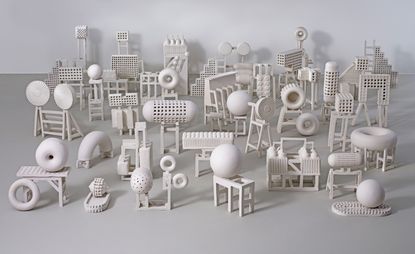
Ceramics and art have a companionship longer than most. In a story that began in the Palaeolithic period, this potent fusion of water, earth and creativity has evolved through many modes. 21st-century ceramic artists are proving that the medium has as much potential for concept as function, lured in by its versatility, sensuality and role as a platform for provocation.
From artists upholding age-old techniques with a twist, to those unearthing radical ways to push materials to their limits, these are the trail-glazers, the mould-breakers and future-shapers on the cutting edge of ceramic art.
Sin-Ying Ho

In her deft cut-and-paste approach, Sin-Ying (Cassandra) Ho fuses together fragments of East and West. Self-described as a ‘global sapien’, Ho creates work reflective of the multicultural cities she’s inhabited, including New York, Toronto, her birthplace of Hong Kong, and Jingdezhen where she lives and works. Ho’s cross-cultural ceramic art is an amalgam of life experiences and observations; European and Chinese elements, decorative motifs and images from past and present collide to create concepts that are fundamentally contemporary. Ho’s solo show, ‘Constructed realities: Life Beyond Borders’ will open on 6 October at Nilufar Gallery, Milan.
Jonathan Baldock

Jonathan Baldock, Facecrime (suspect), 2020. Ceramic, steel, hand-spun yarn. Copyright Jonathan Baldock. Courtesy the artist and Stephen Friedman Gallery, London.
Jonathan Baldock’s ingenious recipe of wit, grotesqueness, empowerment, mortality, and surrealism is as much ceramic art as theatre. The British artist’s multidisciplinary practice often merges ceramics, painting, sound, metal, textiles and performance to stretch the possibilities of his materials. Baldock – who recently created a striking window display for the Renzo Piano-designed Hermès Flagship store in Tokyo – is best known for incorporating biological forms into his work: disembodied ears, beckoning fingers, or contorted hands pushing and punching, which explore childhood fears, adult desires and the space occupied by the human body. As the artist has said, ‘All bodies are good bodies’.
Shawanda Corbett

Shawanda Corbett, Stop all that slouching, boy, 2021, Glazed stoneware.
American multidisciplinary artist Shawanda Corbett is breaking the mould of ceramic art. Her performative pottery – incorporating dance, music and poetry – is shaped by global histories and theories around a ‘complete body’. Corbett is a self-described ‘cyborg’ artist, drawing on Donna Haraway’s Cyborg Manifesto (1985). ‘I wanted to use [the book] but with my perspective: a Black woman, queer, disabled and all these other social identities that I have, whether decided or decided for me,’ the Oxford-based artist told us in an interview. Corbett’s ceramic works often comprise totemic, anthropomorphic vessels of different heights, shapes and glazes, their vibrant, glossy surfaces scored with traces of the music Corbett listens to as she works.
Fernando Casasempere

Fernando Casasempere, London Mithraeum Bloomberg SPACE 10 February – 22 July 2022.
When Fernando Casasempere moved to London in 1997, he brought with him over twelve tonnes of his own mixtures of Chilean clay. The ceramic artist has always retained deep connections to the landscape of his native country, through which he confronts urgent global ecological and social concerns with links to the sensibilities of the Land Art movement. His abstract work blends clay with industrial matter, notably waste materials from copper mining (a principal export of Chile) and draws on classical and modern cultural forms such as Pre-Columbian art and Latin American architecture.
Martha Freud

Martha Freud, Fuck This Shit candle
The work of British ceramic artist Martha Freud is a bold fusion of wit, cultural critique, tongue-in-cheek wordplay and philosophical reflection. It was following a degree in furniture and product design that Freud discovered an affinity with ceramics, a moment she describes as ‘love at first sight’. In recent years, Freud has been focussing her energy on motherhood, an experience she has is now channelling into something of an art renaissance. ‘Mixed Messages’ at Nonemore Gallery, London, is Freud’s first solo show in more than a decade and features new works that blend technology and tradition. This includes delicate porcelain tableware and candles which feature witty slogans, life lessons and statements of empowerment: ‘Well, Well, Well If It Isn't The Consequences Of My Own Actions’, ‘Fuck This Shit’ and ‘My Body My Labels’ among them. It takes a certain vision to achieve an impactful balance of profanity, profundity, and poetry, but Martha Freud might have just cracked it.
King Houndekpinkou

Some of the 40 ceramic works King Houndekpinkou created for his current solo show, ‘Dans Mon Jardin...’, at Paris’ Galerie Vallois. Left and centre are unfired works, which have been left to dry next to a window, while far right is a completed sculpture in white and gold.
King Houndekpinkou’s otherworldly ceramic art blends ancestral pottery traditions with space-age video game aesthetics. The Paris-based artist, of Beninese origin, fuses seemingly disparate influences – from Japanese craft, African Voodoo and pop culture to form sculptures bursting with bold colour, playful spikes and cracked surfaces. As he told writer Minako Norimatsu in a profile for our September 2021 issue, ‘It can take a combination of hundreds of powders to obtain a particular colour or texture. Sometimes I rework a piece that is ostensibly finished, applying another layer of glaze and firing it again. Then a new piece is born!’
Brie Ruais

Installation view of 'Brie Ruais: Movement at the Edge of the Land', at the Moody Center for the Arts, Houston. Courtesy of Moody Center for the Arts, Houston and albertz benda gallery, NYC.
Brooklyn-based Brie Ruais uses one primary tool to fashion her dynamic clay pieces: her own body. Each of her sculptures is made with the equivalent of her body weight in clay, resulting in pieces that uncannily mirror human scale. Each gouge, scrape and fold is evidence of raw physical engagement with her material, reminiscent of work by Ana Mendieta and Lynda Bengalis. Ruais’ often creates alone in the desolate desert terrain of Nevada's Great Basin, with no Wi-Fi or phone service. The intensity of solitude, and the charged intimacy with her material, as she rolls, pushes and pulls her body across it, results in works that blur sculpture and performance.
Ron Nagle

Ron Nagle, Tatt-toupee, 2018, Ceramic, glaze, catalyzed polyurethane, epoxy resin, and acrylic.
It’s a rare trait in the arts, but acclaimed American ceramicist and prolific musician Ron Nagle has managed to master two very distinctive mediums with singular zest, conviction and unpredictability. Clay began as a rebellion for Nagle, both against his parents’ ‘closed-minded’ view of suitable vocations, and the conventional ceramic applications that ruled 1950s California. Gaining prominence in his 20s, he joined forces with other like-minded artists, such as Peter Voulkos and Ken Price, and soon found his rhythm. The results were small-scale, huge impact pieces that the artist has been perfecting for the last 60 years. An amalgam of hyper-polished and rugged surfaces combined with spicy, saturated hues, his works are imbued with the legacies of California: pop culture, the Finish Fetish movement and its sun-soaked vernacular.
Zemer Peled

Zemer Peled, I Wanna Dance 1, 2020, porcelain
The more you look at Zemer Peled’s work, the more there is to see. The the Israel-born, LA-based artist’s almost impossibly intricate ceramic sculptures are composed of thousands of porcelain shards to form small and large scale objects that resemble organic forms. Each shard is created from strips or slabs of raw or glazed porcelain that she rolls, smashes then affixes to her works. Often taking colour cues from the blue cobalt of Japanese pottery, the artist examines the beauty and brutality of the natural world and delves into themes of memory, identity and place. The resulting works – almost appearing soft from afar, and playful yet ominously spiky up close - resemble something between blooming flora, undulating sea anemones or something entirely abstract.
Magdalene Odundo

Left: Untitled, 1990, burnished and carbonised terracotta by Magdalene Odundo. Right: The artist in her Surrey studio. Photography by Sophie Green for the March 2019 issue of Wallpaper* (W*240)
Over a four-decade career, the Kenyan-born British studio potter and revered educator has made a tangible mark on ceramic art. Her restrained, often asymmetrical sculptures allude to the curvature of the female human form and affirm the inextricable and profound link between humanity and clay. As a young ceramic artist, she travelled to Nigeria, New Mexico and China, immersing herself in various approaches to craftsmanship. The artist’s hollow vessels carry a catalogue of global histories, technical approaches and cultures: graphic design - which she first trained in - diasporic identities, British studio pottery, ceremonial vessels from Kenya and Nigeria and Ancient Greek and Roman techniques. In place of the potters’ wheel, Odundo makes use of a coiling technique to hand-build her vessels, which she fires and burnishes repeatedly. The resulting objects have a surface akin to satin, and range in colour from flaming orange to subdued black, and sometimes a combination of the two. Odundo’s solo show at Salon 94’s newly-renovated 89th Street location will be on view until 3 July 2021 in New York.
Ai Weiwei

Ai Weiwei, Coca Cola Vase, 2011. Han Dynasty vases (206BC-220AD) and industrial paint.
Chinese artist and activist Ai Weiwei is just as famed for breaking ceramic art as making it. In 1995, in one of the most memorable and controversial moments of art-world theatre, he intentionally dropped an alleged 2,000-year-old Han Dynasty Urn, which shattered at his feet. A year before, Ai painted over another with the red Coca-Cola logo. This erasure of artefacts – and ergo cultural history - is a recurring theme in Ai’s work, with ancient ceramic vessels often his tools of choice to question who or what ascribes cultural value. In a different, but no less striking ceramic mode, Ai dominated Tate’s turbine hall with 100 million individually hand-crafted life-sized sunflower seeds sculpted and painted by specialists in Jingdezhen, China. It was an invitation to reflect on the ‘Made in China’ phenomenon, and more broadly, contemporary cultural exchange. Ai confronts the vast history of ceramic art, smashes it open and pieces it back together to astonishing, and explosive effect.
Grayson Perry

Grayson Perry, The Rosetta Vase, 2011.
A mere whisper of the term ‘ceramic art’ is usually enough to bring Grayson Perry’s work into the conversation. The artist’s command of the medium as a storytelling device is nonpareil, chronicling scenes of contemporary British life with wit, poignancy and nostalgia. At first glance, these pieces are alluring, playful and spirited. A closer inspection often brings with it a change in mood, as his sgraffito surfaces reveal loaded stories of prejudice, injustice, desire, disaster, religion, mass media and power. His work – which also extends across cast iron, bronze and printmaking – is dense with autobiographical references and unflinching societal statements. Perry simultaneously flips ceramics on its head to question the social status of the medium itself – turning its purity into a vehicle for fiery allegory.
Genesis Belanger

Ceramic sculptures by Genesis Belanger, shot in her Brooklyn studio for the October 2020 issue of Wallpaper* (W*258).
In the work of Brooklyn-based sculptor Genesis Belanger, nothing is quite what it seems. Demure pastel hues and mundane objects are skewered with sharp wit and cultural critique - ingredients that make for uncanny visual consumption. Unlike many ceramic artists, Belanger eschews glazes in favour of a matte surface. Colours use either the natural tones of the clay or involve blending pigments into the stoneware or porcelain. Often involving mid-century furniture, pills, food, telephones, candles, flowers and displaced body parts, Belanger’s ceramic compositions are smorgasbords of surprise and conceptual depth. Each piece is packaged like a surreal novella, bound up in contemporary realism: feminist critiques of contemporary America, vanity, excess, consumerism, and in a 2020 show at The Aldrich, grief and loss.
Theaster Gates

Theaster Gates’s Ceramics Studio, Chicago, 2020.
American artist Theaster Gates has a practice of many facets. Through his socially-engaged art, Gates delves into race, territory, and the history of objects. He trained as a potter, and maintains a deep affinity with clay. For Gates, the ceramic vessel is rooted in metaphor: a container of spirituality, ritual and universality, and architecture for shared experiences. Last year, Gates staged ‘Black Vessel’ at Gagosian New York, in which he created a space for contemplation through large-scale works in glazed and fired clay. The artist’s ability to unify age-old traditions and ceramic sensitivities with contemporary themes and aesthetics anchors him as a forerunner of contemporary ceramic art, and a great deal more. Read a full interview with Gates for our At Home With series.
Lubna Chowdhary

Lubna Chowdhary, Sign 3, 2020
The work of London-based artist Lubna Chowdhary is all about tensions and hybridity: between manual and industrial, East and West, minimalism and superfluity. Born in Tanzania to Indian parents, the artist creates vivid hand-painted tiles, three-dimensional objects and spacial installations that defy easy categorisation. Chowdhary’s interests lie in the malleability of clay, its relationship with the human hand and colour’s capacity to generate visual and emotional responses. Through her bold lashings of colour, lustrous surfaces and gridlike geometric constructions, the medium is imbued with wide-ranging histories, geographies and cultures. Her new exhibition at Jhaveri Contemporary in Mumbai centres on the concept of code-switching, the act of shifting between linguistic codes and systems. This, in the context of Chowdhary’s work, means an interchange between different modes of production, cultural references and media, conveyed through tiled ceramic work, paintings and collages on paper. Lubna Chowdhary is currently exhibiting at Frieze New York in the Jhaveri Contemporary online viewing room.
Zizipho Poswa

Powsa in her studio, working on her Umthwalo series, inspired by the way local women carry heavy loads on their heads. In the background is a finished work titled Umthwalo 4. Shot for the October 2019 issue of Wallpaper* (W*247)
The Cape Town-based ceramicist’s titanic totemic works, vividly hued and often of variegated parts, are deeply rooted in her experience as a Xhosa woman. In 2006, Poswa co-founded Cape Town ceramic studio Imiso, a leap that allowed her to translate her training in textile design into the ceramic sphere. Her relatively recent success as an independent artist came after two decades of dedication to clay as a vehicle for expression, and as a business. Her stoneware pieces, ambitious in scale and often composed of different parts, draw on Xhosa rituals and textiles, the water vessels carried by Xhosa women, and African hairstyles. Texture plays a central role in Poswa’s work: course surface treatments are often juxtaposed with silky smooth appendages (or vice versa), and other striking embellishments that bridge the gap between tradition and modernity.
Harriet Lloyd-Smith is the Arts Editor of Wallpaper*, responsible for the art pages across digital and print, including profiles, exhibition reviews, and contemporary art collaborations. She started at Wallpaper* in 2017 and has written for leading contemporary art publications, auction houses and arts charities, and lectured on review writing and art journalism. When she’s not writing about art, she’s making her own.
-
 Conner Ives: ‘I want to blow apart our idea of what sustainability is’
Conner Ives: ‘I want to blow apart our idea of what sustainability is’Next Generation 2023: American designer Conner Ives’ 2000s-tinged collections imbue upcycled garments with newfound glamour – but he’s much more than just another ‘sustainable designer’
By Tilly Macalister-Smith • Published
-
 Flexjet takes to the skies with Bentley
Flexjet takes to the skies with BentleyFlexjet brings exclusive Bentley interiors to its new Gulfstream G650 jet and Sikorsky S-76 helicopter, in the smoothest of transfers
By Jessica Klingelfuss • Published
-
 Year in review: top 10 design stories of 2022, selected by Wallpaper* design editor Rosa Bertoli
Year in review: top 10 design stories of 2022, selected by Wallpaper* design editor Rosa BertoliTop 10 design stories of 2022 – from 2023 horoscopes to exclusive interviews with design’s most brilliant minds
By Rosa Bertoli • Published
-
 Vanessa Beecroft’s ethereal performance and sculpture exhibition explore Sicily’s cultural history
Vanessa Beecroft’s ethereal performance and sculpture exhibition explore Sicily’s cultural historyAt the historic Palazzo Abatellis, Sicily, Vanessa Beecroft has unveiled ‘VB94’, a new tableau vivant comprising a one-time performance and a new series of sculptures, the latter on view until 8 January
By Hili Perlson • Published
-
 The best 12 art gifts for the creative in your life
The best 12 art gifts for the creative in your lifeGet inspired with our ongoing guide to the best art gifts for the 2022 Christmas season
By Harriet Lloyd-Smith • Published
-
 London art exhibitions: a guide for this week
London art exhibitions: a guide for this weekYour guide to the best London art exhibitions, and those around the UK, as chosen by the Wallpaper* arts desk
By Harriet Lloyd Smith • Last updated
-
 Veronica Ryan wins the 2022 Turner Prize
Veronica Ryan wins the 2022 Turner PrizeVeronica Ryan, the artist who honoured the Windrush generation, has been named winner of the 2022 Turner Prize in a ceremony held in Liverpool
By TF Chan • Published
-
 Zizipho Poswa’s new ceramics and photography explore hair as a medium for sculpture
Zizipho Poswa’s new ceramics and photography explore hair as a medium for sculptureAt Southern Guild Gallery, Cape Town, Zizipho Poswa draws on the elaborate hairstyling practised by African women in a new series of ceramics, bronze sculptures and photographs
By Jareh Das • Published
-
 Textile artists: the pioneers of a new material world
Textile artists: the pioneers of a new material worldThese contemporary textile artists are weaving together the rich tapestry of fibre art in new ways
By Harriet Lloyd-Smith • Published
-
 Theaster Gates’ New Museum exhibition meditates on mourning, materials and community
Theaster Gates’ New Museum exhibition meditates on mourning, materials and communityTheaster Gates talks about his first US museum show, ‘Young Lords and Their Traces’ at The New Museum
By Pei-Ru Keh • Published
-
 ‘Strange Clay’ review: a mucky, uncanny, visceral survey of ceramic art
‘Strange Clay’ review: a mucky, uncanny, visceral survey of ceramic artAt London’s Hayward Gallery, group show ‘Strange Clay: Ceramics in Contemporary Art’ sees ceramic artists explore the physical, psychological, political and power of their medium
By Emily Steer • Last updated
